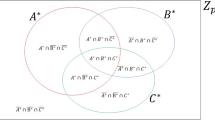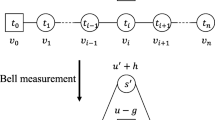Abstract
Recently, Liu and Yin (Int. J. Theor. Phys. 60, 2074-2083 (2021)) proposed a two-party private set intersection protocol based on quantum Fourier transform. We find the participant can deduce the other party’s private information, which violates the security requirement of private set computation. In order to solve this problem, an improved private set intersection protocol based on Hadamard gate is proposed. Firstly, the more feasible Hadamard gates are used to perform on the original n qubits instead of the quantum Fourier transform, which may reduce the difficulty of implementation. In addition, through the exclusive OR calculation, the participant’s private information is randomly chosen and encoded on the additional n qubits, which prevents participants from obtaining the result of the difference set Sdiff, and then avoids the internal leakage of private information. Finally, the correctness and security analysis are conducted to show the proposed protocol can guarantee the correctness of computation result as well as resist outside attacks and participant internal attacks.

Similar content being viewed by others
References
Yao, A.C.: Protocols for secure computations. Symp. Found. Comput. Sci. (FOCS). 23, 160–164 (1982)
Shor, P.W.: Algorithms for quantum computation: Discrete logarithms and factoring. Symp. Found. Comput. Sci. (FOCS). 35, 124–134 (1994)
Grover, L.K.: Quantum mechanics helps in searching for a needle in a haystack. Phys. Rev. Lett. 79(2), 325–328 (1997)
Xu, Y.S., Liu, W.J., Yu, W.: Quantum forgery attacks on COPA, AES-COPA and marble authenticated encryption algorithms. Quantum Inf. Process. 20(4), 131 (2021)
Liu, W.J., Xu, Y., Yang, C.N., et al.: An efficient and secure arbitrary N-Party quantum key agreement protocol using bell states. Int. J. Theor. Phys. 57(1), 195–207 (2018)
Liu, W.J., Li, C.T., Zheng, Y., et al.: Quantum Privacy-Preserving price E-Negotiation. Int. J. Theor. Phys. 58(10), 3259–3270 (2019)
Wooters, W.K., Zurek, W.K.: Quantum no-cloning theorem. Nature, 299 (1982)
Folland, G.B., Sitaram, A.: The uncertainty principle: A mathematical survey. J. Fourier Anal. Appl. 3(3), 207–238 (1997)
Mayers, D.: Unconditional security in quantum cryptography. ACM. https://doi.org/10.1145/382780.382781 (1998)
Shi, R.H., Mu, Y., Zhong, H., Cui, J., Zhang, S.: An efficient quantum scheme for Private Set Intersection. Quantum Inf. Process. 15(1), 363–371 (2016)
Cheng, X., Guo, R., Chen, Y.: Cryptanalysis and improvement of a quantum private set intersection protocol. Quantum Inf. Process. 16(2), 37 (2016)
Maitra, A.: Quantum secure two-party computation for set intersection with rational players. Quantum Inf. Process. 17(8), 197 (2018)
Debnath, S.K., Dey, K., Kundu, N., et al.: Feasible private set intersection in quantum domain. Quantum Inf. Process. 20(1), 41 (2021)
Liu, W., Yin, H.W.: A novel quantum protocol for private set intersection. Int. J. Theor. Phys. 60, 2074–2083 (2021)
Shi, R.H.: Quantum Private Computation of Cardinality of Set Intersection and union.The European Physical Journal D - Atomic, Molecular, Optical and Plasma Physics. https://doi.org/10.1140/epjd/e2018-90380-7 (2018)
Shi, R.H.: Efficient quantum protocol for private set intersection cardinality. IEEE Access. 99, 1–1 (2018)
Shi, R.H., Zhang, M.: A feasible quantum protocol for private set intersection cardinality. IEEE Access. 7, 72105–72112 (2019)
Liu, B., Zhang, M.W., Shi, R.H.: Quantum secure multi-party private set intersection cardinality. Int. J. Theor. Phys. 59, 1992–2007 (2020)
Shi, R.H., Mu, Y., Zhong, H., Zhang, S.: Quantum oblivious set-member decision protocol. Phys. Rev. A. 92(2), 5 (2015)
Gao, F., Qin, S.J., Wen, Q.Y., et al.: A simple participant attack on the Bradler-Dusek protocol. Quantum Inform. Comput. 7(4), 329–334 (2007)
Song, T.T., Wen, Q.Y., Gao, F., et al.: Participant attack and improvement to multiparty quantum secret sharing based on GHZ states. Int. J. Theor. Phys. 52(1), 293–301 (2013)
Li, L., Shi, R.H.: A novel and efficient quantum private comparison scheme. J. Korean Phys. Soc. 75(1), 15–21 (2019)
Deng, F.G., Han, X., et al.: Erratum: Improving the security of multiparty quantum secret sharing against Trojan horse attack. Phys. Rev. A. 73(4), 49901–49901 (2006)
Peev, M., Pacher, C., Lorunser, T., et al.: Response to “Vulnerability of ’A novel protocol-authentication algorithm ruling out a man-in-the-middle attack in quantum cryptography’ ”. Int. J. Quantum Inf. 07(7), 1401 (2009)
Kye, W.H., Kim, C.M., Kim, M.S., et al.: Security against the invisible photon attack for the quantum key distribution with blind polarization bases. Phys. Rev. Lett. 95(4), 040501 (2005)
Lo, H.K., Ma, X., Chen, K.: Decoy state quantum key distribution. Phys. Rev. Lett. 94(23), 230504 (2005)
Ma, X., Qi, B., Zhao, Y., et al.: Practical decoy state for quantum key distribution. Phys. Rev. A. 72(1), 1–127 (2005)
Ye, T.Y., Jiang, L.Z.: Improvement of controlled bidirectional quantum direct communication using a GHZ state. Chin. Phys. Lett. 30(4), 40305–040305 (2013)
Liu, W.J., Chen, Z.Y., Liu, J.S., et al.: Full-Blind Delegating private quantum computation. CMC-Computers Materials and Continua 56(2), 211–223 (2018)
Acknowledgements
The authors would like to thank the anonymous reviewers and editors for their comments that improved the quality of this paper. This work is supported by the National Natural Science Foundation of China (62071240, 61802002), and the Priority Academic Program Development of Jiangsu Higher Education Institutions (PAPD).
Author information
Authors and Affiliations
Corresponding author
Ethics declarations
Ethics statement
Articles do not rely on clinical trials.
Conflict of Interests
The authors declare that they have no conflict of interest.
Additional information
Human and animal participants
All submitted manuscripts containing research which does not involve human participants and/or animal experimentation.
Publisher’s Note
Springer Nature remains neutral with regard to jurisdictional claims in published maps and institutional affiliations.
Rights and permissions
About this article
Cite this article
Liu, WJ., Li, WB. & Wang, HB. An Improved Quantum Private Set Intersection Protocol Based on Hadamard Gates. Int J Theor Phys 61, 53 (2022). https://doi.org/10.1007/s10773-022-05048-3
Received:
Accepted:
Published:
DOI: https://doi.org/10.1007/s10773-022-05048-3




